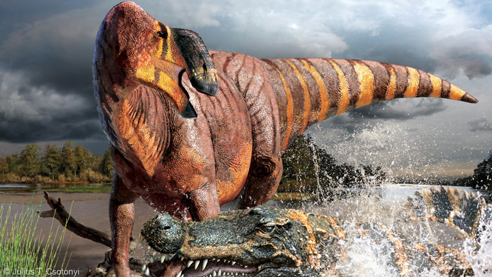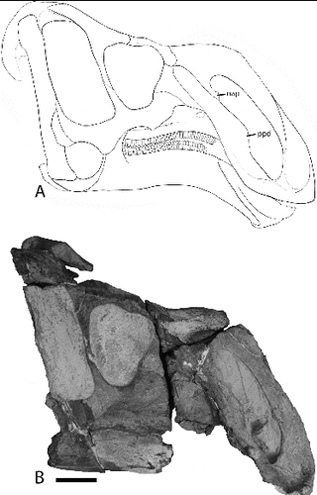“Big Nose” Dinosaur – New Hadrosaur Species Described
Rhinorex condrupus – “King of the Dinosaur Noses”
A team of researchers from Brigham Young Museum of Palaeontology and North Carolina State University (North Carolina Museum of Natural Sciences) have described a new type of duck-billed dinosaur, one with an enormous “conk”. Duck-billed dinosaurs are well-known for sporting elaborate crests, even combs after recent research into the Edmontosaurus genus, but roaming the estuarine habitat of Utah around 75 million years ago was Rhinorex, a duck-billed dinosaur whose genus name translates as “Nose King”.
The “Nose King”
An Illustration of Rhinorex (R. condrupus)
Picture credit: Julius Csotonyi
Terry Gates, a post-doctoral researcher with North Carolina Museum of Natural Sciences and North Carolina State University, collaborated with Rodney Scheetz (Brigham Young), to analyse the skull of a specimen that had been excavated from the Book Cliffs area of east-central Utah in the 1990s. This strata forms part of the Neslen Formation which consists of a series of sedimentary layers of rock representing both marine and terrestrial environments.
Rhinorex condrupus
The specimen had been studied as associated with the fossil skull bones, were some very well preserved skin impressions. However, it was only when the scientists constructed the skull that they realised they had a new species on their hands.
Commenting on their findings, which are reported in the Journal of Systematic Palaeontology, Terry Gates stated:
“We had almost the entire skull, which was wonderful, but the preparation was very difficult. It took two years to dig the fossil out of the sandstone it was embedded in. It was like digging a dinosaur skull out of a concrete driveway.”
Incomplete Skeleton
Although the skeleton is far from complete, unique morphologies of the skull indicate that this is a new species of duck-billed dinosaur, a member of the Hadrosauridae family. The dinosaur has been named Rhinorex condrupus. The name translates as “king nose buried in the cliffs”, the genus name makes reference to the unique shape of the nasal bones and premaxilla. These bones indicate that this plant-eating dinosaur had a large, fleshy nose.
Whilst it is difficult to estimate the exact size of this dinosaur from the fossil bones that have been collected, comparisons with the closely related Gryposaurus and Kritosaurus give a maximum length of around nine metres, with a body weight in excess of three tonnes. The sandstone sediments represent a low lying, swampy, estuarine environment and to date, Rhinorex is the only substantial hadrosaur fossil known from this locality.
Terry Gates explained:
“We have found other hadrosaurs from the same time period [Campanian faunal stage] but located about two hundred miles further south. They may have been adapted to a different environment. This discovery gives us a geographic snapshot of the Cretaceous and helps us to place contemporary species in their correct time and place.”
In essence, “King Nose” helps to fill a gap in the hadrosaurid family tree.
Hadrosaur Diversity
Many different types of duck-billed dinosaur existed during the later years of the Cretaceous, scientists have found fossils of hadrosaurids in almost all the Upper Cretaceous fossil bearing terrestrial formations in western North America. Although the vast majority of these fossils are far from complete, they suggest that the varied Hadrosauridae family evolved as each genus occupied a relatively small geographical area.
The Reconstructed Skull of R. condrupus
Image credit: Journal of Systematic Palaeontology
The line drawing (A) is labelled with the autapomorphies (unique characters or traits) that distinguish this dinosaur as a new genus, namely the hook-like structure (nap) nasal anteroventral process and the expansion of bone located posteroventrally on the premaxilla (ppd).
Why Such a Big Nose?
The large and fleshy snout remains a bit of a puzzle. It may not be related to an enhanced sense of smell.
Post-doctoral student Terry postulated:
“The purpose of such a big nose is still a mystery. If this dinosaur is anything like its relatives then it likely did not have a super sense of smell, but maybe the nose was used as a means of attracting mates, inter-herd recognition or perhaps it supported a large plant-smashing beak. We are already sniffing out answers to these questions.”
It certainly would have looked a little odd with its enlarged naris. However, when you consider the weird and wonderful saurolophines, Parasaurolophus with its enormous, backward sweeping head crest, Edmontosaurus regalis with a fleshy comb on its head and Tsintaosaurus which may have superficially resembled a unicorn, then we think Rhinorex would have fitted right in.
For models and replicas of hadrosaurs and other Late Cretaceous prehistoric animals: PNSO Museum Quality Age of Dinosaurs Figures.



